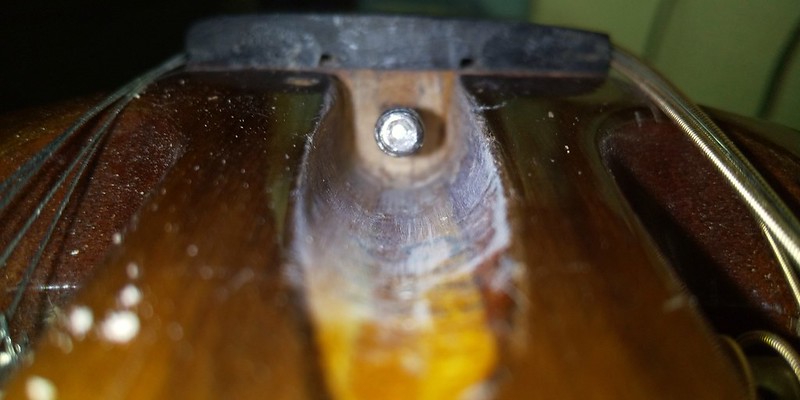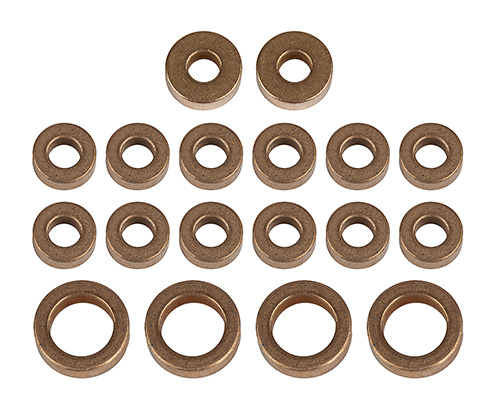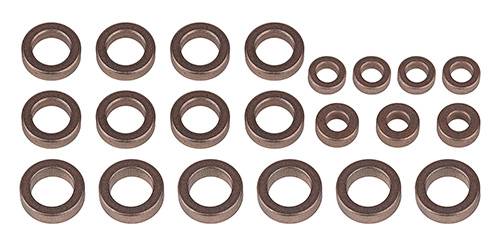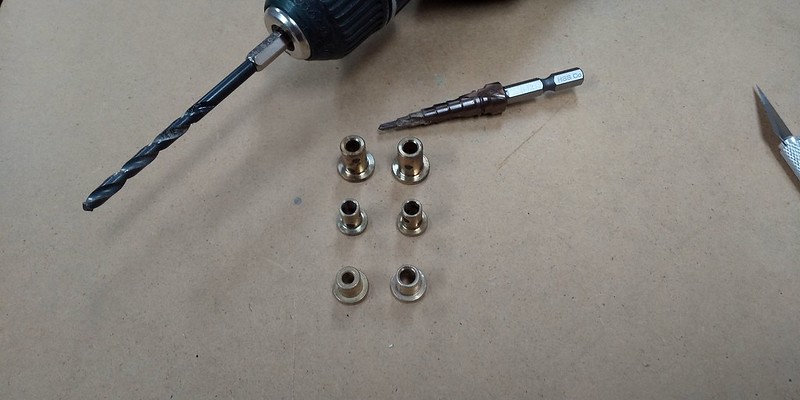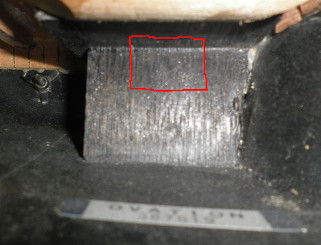|
| ||
| The Ovation Fan Club | ||
| ||
| Random quote: "Got time to breathe, got time for music." --Briscoe Darling. |
 '74 1115-1 Pacemaker Restoration '74 1115-1 Pacemaker Restoration
| View previous thread :: View next thread | |
| Member Communities -> Bottom Feeding Luthiery Guild | Message format | |
| seesquare |
| ||
Joined: November 2002 Posts: 3654 Location: Pacific Northwest Inland Empire | I can personally attest to that. Find a practitioner with the right "touch & technique" and they can achieve amazing results. The majority of the remedy is knowing the cause. | ||
| |||
| arumako |
| ||
Joined: October 2012 Posts: 1091 Location: Yokohama, Japan | Love O Fair - 2023-03-01 11:44 AM Keep this up long enough and they will eventually give you a license to be a chiropractor. Lol! You know, "Guitar Chiropractor" sounds better than "Guitar Hack"! seesquare - 2023-03-01 9:06 PM I can personally attest to that. Find a practitioner with the right "touch & technique" and they can achieve amazing results. The majority of the remedy is knowing the cause. I definitely don't know what is causing the high pressure truss rod adjustment on this 1115-1, but I think I may be close to the remedy! Lol! Didn't have much time today, but a little progress was made...
Took my chisel and thin exacto knife and cleaned around the truss rod. Took Dellef's advice and cleared a relatively straight and flat area upto the fret board.
It was a bit difficult to get at the area behind the fret board, but patience definitely paid off here! Took my mini-file and 120 grit sandpaper and we're good to go!
Now, I just need to decide what material to use as an insert. Carbon fiber, aluminum, Ebony, African Black Wood or something else? | ||
| |||
| seesquare |
| ||
Joined: November 2002 Posts: 3654 Location: Pacific Northwest Inland Empire | Unobtainium. Jus' kiddin'. How's about a brass insert? Softer than the steel washer & nut, but harder & less apt to crush or split than wood fiber. You can probably find a brass bushing with the correct I.D & O.D., then cut it to length. | ||
| |||
| Love O Fair |
| ||
Joined: February 2016 Posts: 1881 Location: When?? | Since the rod-bend is being so uncooperative, I tend to agree with your thoughts on aluminum or with Seesquare on the brass option after seeing the result of your wood insert splintering (though as long as there is zero possibility of a metal insert rising up against the end tip or underside of the fretboard). Heck.. maybe you could get really inquisitive and take it to an aforesaid friendly chiropractor or applicable elsewhere for an x-ray to see just how far down the neck the rod is actually bending. Edited by Love O Fair 2023-03-02 7:58 PM | ||
| |||
| DanSavage |
| ||
Joined: June 2012 Posts: 2340 Location: Pueblo West, CO | arumako - 2023-03-02 10:33 AM Now, I just need to decide what material to use as an insert. Carbon fiber, aluminum, Ebony, African Black Wood or something else? Quite a project you've got going, Ken. Personally, I would use a bronze bushing. I've used bronze wheel bushings off R/C cars for bottomed-out TR nuts that needed spacing. The nice thing about R/C car bushings is that they have a small-ish outer diameter and a large-ish inner diameter. They're also thicker than a washer so you'd only need one. This allows them to fit over the TR and stay inside the TR cavity in the head stock. Here's a couple of photos of a sintered bronze bushing I used on a 1617 I re-topped. These particular bushings came from Team Associated and were for their RC10 car. I think these have been discontinued. I looked on the Team Associated web site and found this bushing set for another car. (Enduro SE) They don't have any specs, so you'd have to order a set to confirm whether one in the set fits your application.
They also have another set of bushings for their Reflex 14R.
You could also call around to your local hobby stores to see if they have anything that might fit. Yet another possibility would be R/C airplane wheel collars and for the same reason -- large hole, small outer diameter and thicker than a washer. They are usually nickel-plated brass or stainless steel.
Keep up the good work. Edited by DanSavage 2023-03-03 1:27 PM | ||
| |||
| tpa |
| ||
Joined: December 2004 Posts: 577 Location: Denmark | If the rod has been bent out of shape a few times it will loose strength. It is becoming interesting to see what is below the fretboard, isn't it? Edit: Looking at this indicates what might be in there. I would probably use a brass shim wide enough to rest against wood at the sides and thick enough to transfer the force. A bronze shim as proposed by Dan would give a good bearing. Give the thread some molykote grease to reduce friction and thereby the risk of breaking the truss rod when tightening the nut. Edited by tpa 2023-03-03 5:03 PM | ||
| |||
| DanSavage |
| ||
Joined: June 2012 Posts: 2340 Location: Pueblo West, CO | tpa - 2023-03-03 2:36 PM A bronze shim as proposed by Dan would give a good bearing. Give the thread some molykote grease to reduce friction and thereby the risk of breaking the truss rod when tightening the nut. FWIW, most sintered bronze bushings are self-lubricating. They're known in the industry as "Oilite." During the manufacturing process the resulting bearing has microscopic pores and they're vacuum-impregnated with SAE 30W oil. Total volume of oil in the bushing is in the neighborhood of 20%. Because of the oil being present and the porous surface, it's recommended that they not be machined, filed, ground or reamed as this will clog the pores unless an extremely sharp tungsten carbide bit is used. | ||
| |||
| arumako |
| ||
Joined: October 2012 Posts: 1091 Location: Yokohama, Japan | DanSavage - 2023-03-03 3:18 AM Here's a couple of photos of a sintered bronze bushing I used on a 1617 I re-topped. Dang! Thanks Dan! I shoulda known you've "been there, done that." Really appreciate the pics and encouragement. tpa - 2023-03-03 6:36 AM If the rod has been bent out of shape a few times it will loose strength. Note taken. That's going to be a huge concern moving forward. Don't think more truss rod bending is necessary. Hoping the minimal bending I did doesn't compromise the rod's integrity too much! Thanks for chiming in everybody. The BFLG continues to be such a valuable resource - Arigatou. After reading your suggestions, I spent a day just looking for brass, bronze, and aluminum fittings that might work. The hobby shops in Japan have a bunch of Aluminum stuff, but not much bronze or brass. So I ordered a few parts off the net to see if I might find some Unobtanium! The cut around the truss rod is 1/2 in. (approx. 12mm) in diameter. Since it's been cut flush up to the finger board, my thinking is a 1/2 inch or 12mm anchor would really help spread the load of the truss rod nut over a larger area.
2). Bronze flange bearing (oil impregnated):
11mm flange OD, 8mm shaft OD, 4mm bore (will need to ream to 5mm). I think this is the stuff Dan was talking about. Thinking a flange would provide better overall stability than a sleeve. Also, the nice thing about a flange bearing is that, I can cut a 1/2 in. OD Ebony dowel, drill a 8mm hole and cover the bearing shaft with some ebony or other wood. This way the flange bearing will be encased in Ebony and will glue into the truss rod cavity more securely. Does that make sense? My only concern was, since it is an oil impregnated bearing, the ebony may weaken over time and crack. 3). Brass flange sleeve bearing (oil-less):
11mm flange OD, 7mm shaft OD, 5mm bore. Same logic as the bronze flange bearing, but this one is not oil impregnated. Might be better than the bronze oil impregnated bearing if I encase the bearing with a wood sleeve. Ordered all three of the above to test, but thinking one of these will prove to be the Unobtanium! Any thoughts? Will need to wait a week or so for all three to arrive. Meanwhile, I guess I should get started on reinforcing the neck/headstock area. I found out they call this area the "volute" while researching for my reinforcement! Thinkin' it's a good sign that I'm still able to learn...Lol? | ||
| |||
| seesquare |
| ||
Joined: November 2002 Posts: 3654 Location: Pacific Northwest Inland Empire | Diamond volute idea for reinforcement (mahogany-bolt-on-carved-neck-254-255-shallow-heel-diamond-volute.jpg) Attachments ----------------  mahogany-bolt-on-carved-neck-254-255-shallow-heel-diamond-volute.jpg (50KB - 1 downloads) mahogany-bolt-on-carved-neck-254-255-shallow-heel-diamond-volute.jpg (50KB - 1 downloads) | ||
| |||
| arumako |
| ||
Joined: October 2012 Posts: 1091 Location: Yokohama, Japan | Hey OFC/BFLG! Back with some heart break. Yup, in true hack form (just as TPA warned), I broke the truss rod on this beautiful 1115-1. Bummer! But in hopes that my mistake is not repeated, thought it would be good to leave a record of how I went about attempting the fix... prepare your heart for some guitar carnage Since this truss-rod adjustment exerted unusually high pressure (at least in my estimation), I figured the cavity receiving the washer and nut needed to be as flat as possible so some final prep was performed using a 12 mm dowel with a 5mm bore. Some 60 grit sand paper was double-stick taped to the end.
Just insert the rod and rotate...
Once flatness was satisfactorily achieved needed to select the best flange bearing for the job. The aluminum rod extension cylinder hasn't arrived yet, but these fixtures would be better suited for this project anyway. Bored the bronze flange bearing's (bottom) ID needed from 4mm (L) to 5mm (R). The brass flange bearings (middle) have the right ID, but is a bit long. The larger flange bearing (top) would need to be machined further for a good fit (top) so gonna go with the bronze flange bearing.
Performed some dry runs. Again, recalling to mind the extensive force applied to the truss rod cavity, I decided to add a hard paper plumbing washer (the blue thing) between the wood and the bronze flange bearing in hopes that some of the pressure would be absorbed by the paper washer and spare any wood deformation that might occur (in retrospect, I think this worked very well)...
One final thing was to make sure the string nut fit over the "flange" of the flange bearing. Was originally planning on hacksawing the flange, but decided instead to file the underside of the string nut. Always thought these nuts were bone, but this one was plastic and easy to form.
Then it was time to string her up. Figured this guitar will never wear anything more than extra light gauge strings. DAd's EJ41s are PB and suited to the task. Tightened the truss rod nut to make the neck dead straight, and installed the strings from outside to in.
Once strung, the truss rod nut was tightened as the guitar was tuned to concert pitch. To my surprise the headstock/neck joint was very stable thanks to the truss rod being pulled straight and true. The nut did not seem to be too tight at all and felt easy to turn. Performed a quick set-up and everything was almost perfect. At this point, I was able to verfiy that this guitar sounds magnificent (which bodes well for the future of this guitar)! But then, I thought, "Just one quarter-turn more..." and the heart sinking, "SNAP!" (Warning! guitar carnage ahead...)
After some time, I was able to compose myself and begin the evaluation process (all the time thanking God that this wasn't a friend's guitar!). First thing that jumped out at me was the bronze oil impregnated flange bearing was sweating oil. Took the broken off assembly apart and check this out...
The left is a new bronze flange bearing. On the right is the one I used for this project. Didn't even notice how much this thing was compressing, but I've never seen a truss rod adjustment that could do this to bronze - attesting to my true "hack" status because that just means I was obliviously applying way too much pressure (hence sweating oil)... on the other hand, the neck was still moving as the truss rod was tightened; and IMHO it would have straightened out even more had the truss rod not snapped... But the glimpse of this guitar's voice I heard but for a brief moment is enough to keep this guitar in my fold until it is fixed. Thinking there's one more thing I can try with the exposed threads on the truss rod by using one of these female barrel nuts and a sleeve.
With the right length, the barrel nut can thread into the truss rod and pull it while a flanged sleeve can provide leverage, but then this truss rod pulls with some serious force... might just need to install a new truss rod. What to do? What to do? In any case, here's to hoping that this information might prevent some future BFLG guitar carnage. Thanks for letting me share my journey. Sorry that this one is so anti-climactic, but it will be back - fingers crossed... | ||
| |||
| seesquare |
| ||
Joined: November 2002 Posts: 3654 Location: Pacific Northwest Inland Empire | "Necessity is the Mother of Invention". Keep after it, Ken! As Thomas Edison was quoted, "Genius is 1% inspiration & 99% perspiration." | ||
| |||
| tpa |
| ||
Joined: December 2004 Posts: 577 Location: Denmark | How is the truss rod anchored in the far end? Can the neck be separated from the body? What I think is to pull the rod out and replace it. Edited by tpa 2023-03-11 8:31 AM | ||
| |||
| DanSavage |
| ||
Joined: June 2012 Posts: 2340 Location: Pueblo West, CO | Yikes! You could use the relief cutter to deepen the hole around the TR. As it turns out, they also sell steel spacers in three thicknesses. Who knew? Worse case scenario would be having to cut new threads on the TR. They sell a die to cut threads, but it's very pricey. | ||
| |||
| DanSavage |
| ||
Joined: June 2012 Posts: 2340 Location: Pueblo West, CO | tpa - 2023-03-11 6:27 AM How is the truss rod anchored in the far end? Can the neck be separated from the body? What I think is to pull the rod out and replace it. The TR has a metal slug welded on the end of the neck heel. With a glued neck and a cloth bowl like this guitar has, I would not recommend attempting to remove the neck. The risk of separating the neck block from the bowl is too great. The only way to remove the TR is to first remove the fretboard from the neck, then dig the TR out of the slot that's milled into the neck. Here's what the other end of the TR looks like. | ||
| |||
| arumako |
| ||
Joined: October 2012 Posts: 1091 Location: Yokohama, Japan | Thanks Seesquare, and thanks for the encouragement everybody! Will be looking for the right fasteners to see if my barrel nut/sleeve idea is do-able over the next couple o-days. Meanwhile... tpa - 2023-03-10 10:27 PM How is the truss rod anchored in the far end? ... What I think is to pull the rod out and replace it. My thoughts exactly TPA. As Dan says, removing the neck is probably not the best option especially with my current skillset. But this drawing that you shared sheds some light on how the rod is installed. The triangulated neck block suggests an older (maybe 60s?) design.  My 1115 has a standard neck block (70s on). Both probably use the same truss-rod design in a different neck block. Additional clarity is provided by Dan's pic (Thanks Dan!). Maybe the rod can be removed out of the neck without removing the neck or the fret board? @Dan - So assuming my barrel nut + sleeve idea doesn't work, do you think it's possible to cut through the neck block to the truss rod end through the sound hole and pull the rod out through the sound hole? I'd rather not remove the fret board to get to the rod if I don't have too, and these older rods require a concave groove to be cut in the neck with a symetrically concave wood cover to ensure the rod stays curved inside the neck. A cut in the middle of the neck block from inside the sound hole might provide enough access to pull the rod out (there's enough rod sticking out of the headstock to lightly pound it out too), and the hole created in the neck block can be filled (it might not even need to be filled). Seems over all structural integrity won't be compromised? In either case, some welding/threading will be necessary to make an appropriate replacement truss rod (I'm sure nobody sells anything like this anymore!). Your expert advice/thoughts would be highly appreciated - please! Thanks again for chiming in everybody! | ||
| |||
| tpa |
| ||
Joined: December 2004 Posts: 577 Location: Denmark | As in opening here: by removing wood ? | ||
| |||
| arumako |
| ||
Joined: October 2012 Posts: 1091 Location: Yokohama, Japan | tpa - 2023-03-12 12:33 AM As in opening here: by removing wood ? Yeah TPA, exactly... Crazy, huh? But if I can get my mini craft tool and cut an opening, I should be able to pound the current rod out by directing it through the sound hole. Welding a similar piece to an iron bar of same dimensions and threading the end will be pretty easy (the threads and nut will all be metric though). I've removed and replaced fret boards in the past, and I get the feeling that cutting a rectangular hole in the neck block might be considerably easier? Of course, my assessment might be way way off... | ||
| |||
| tpa |
| ||
Joined: December 2004 Posts: 577 Location: Denmark | For a new truss a round steel bar threaded from one or both ends would work depending on how you anchor the far end. Which thread is the original? I have no idea if metric or imperial. Looking at the figure, it seems thickest wood is between the fretboard and the rod and thinnest wood is on the back (around the number "82" on the figure). What is plan B if pounding the rod breaks the thin wood on the back of the neck? Would it make sense to stabilize back of the neck with a beam of some kind while pounding. Edited by tpa 2023-03-12 11:26 AM | ||
| |||
| tpa |
| ||
Joined: December 2004 Posts: 577 Location: Denmark | Would removing the fretboard allow for straightening of the neck before reassembly - and thus reducing the required tension of the new truss rod? | ||
| |||
| DanSavage |
| ||
Joined: June 2012 Posts: 2340 Location: Pueblo West, CO | Ken, I'm not sure I'd be brave enough to cut away the neck block and hammer the TR out of the neck. Personally, I probably try every other trick to avoid it, even to the point of spending the big bucks to get the Stewmac TR threading tools. | ||
| |||
| tpa |
| ||
Joined: December 2004 Posts: 577 Location: Denmark | Even with additional thread I would expect the truss rod and the wood under direct load to be challenged trying to both straighten the neck and counteract the string tension. Would setting the neck straight by clamping it - maybe for some time and maybe heated with the waterbag trick - help? Edited by tpa 2023-03-12 5:12 PM | ||
| |||
| DanSavage |
| ||
Joined: June 2012 Posts: 2340 Location: Pueblo West, CO | IMO, part of the problem is tuning this guitar to concert pitch. According to Elixir, 12-string lights exert 251 lbs. of tension. I'm assuming this measurement was done with the guitar tuned to concert pitch. I found another site that talks about tuning 12-strings down and shows a chart with a 12-string tuned down 1-1/2 steps and the tension is ~173 lbs. which is about the same as a six string with light-medium strings tuned to concert pitch. Extra light strings only pull ~131 lbs. I'd imagine that with tuning down to a full step would equal right around 200 lbs. of tension, which is where I keep my 12-strings tuned. (1655 & 1758) Personally, I don't thing clamping and heat would do the trick. As soon as the strings go on, the tension would pull the neck forward again. The fact that Ken's sintered bronze bushing got squished and distorted says a lot about how much force was being exerted on it. Edited by DanSavage 2023-03-12 6:35 PM | ||
| |||
| Love O Fair |
| ||
Joined: February 2016 Posts: 1881 Location: When?? | Speaking of carnage, the last dozen or so posts here reminds me of a book I recently read about the crew of the US Navy frigate USS Roberts after it plowed into submerged mines in the Persian Gulf. Bad.. real bad.. and survival required days of construing every unorthodox tactic imaginable.. but an eventual combination of those methods did in fact save her for another 27 years of service. Carry on, Captain Ken! | ||
| |||
| arumako |
| ||
Joined: October 2012 Posts: 1091 Location: Yokohama, Japan | Thanks for your encouragement to think out-of-the-box BFLG! tpa - 2023-03-12 1:05 AM ...Looking at the figure, it seems thickest wood is between the fretboard and the rod and thinnest wood is on the back (around the number "82" on the figure). What is plan B if pounding the rod breaks the thin wood on the back of the neck? Plan B? What plan B? Lol! Area #82 is definitely of concern. However, these truss rods are not glued into their slots and they're threaded only at the tip so theoretically the only resistance that should come into play is the rod rubbing against the curved wood inside the neck. tpa Would it make sense to stabilize back of the neck with a beam of some kind while pounding... If this method is implemented, I will definitely make sure to provide plenty of support for the entire neck and body before the pounding begins! tpa Would setting the neck straight by clamping it - maybe for some time and maybe heated with the waterbed trick - help? I think Dan is right. Any amount of heat to straighten up the wood won't provide any real permanent mechanical change in the wood itself so it will flex right back to where it was originally before the heating process. I use the water bag trick when removing the entire neck from the body, but this 1115's neck is already angled perfectly. If I can take the appropriate amount of bow out of the neck, she will have low action and with a proper fret job - no buzz. So I don't think there's a real need to change the neck-to-body angle or a need to remove the neck entirely. The greater concern might be possible damage to the inside of the top if I pull the rod out of the sound hole. The curved rod might be difficult to manage as I remove it and install the new one. Even if I can get it started with a light pound once the rod is out about an eighth of the way, it's going to start exerting upward force typical of a 1/8" iron bar refusing to straighten up. Of course, I could cut the rod into sections as I pull it out little-by-little, but I'll have to deal with the same issue when installing the new rod (without the luxury of working in smaller pieces) - could be really really troublesome. @Dan - Thanks for all of your valuable input - again! AND for providing info from Elixir! Serious tension exerted on these 12 strings! Arigatou! I think "Mother Necessity" is saying "Start with the barrel nut and sleeve!" I ordered a 12mm length barrel nut which has an OD of 5.9mm. I can first tighten this over the existing truss rod thread to see how much more thread I've got on the rod (all I need is about a 1/4~5/16 inch - if not, the threading tool!). The aluminum rod extender that's on it's way has a 6mm ID (might have to bore it to 7mm to give the barrel nut some wiggle room) and 20mm length. If I cut the rod extender in half to 10mm, the barrel nut will have a 2mm start to begin threading into the broken end of the truss rod which has about 2.5mm of thread sticking out of the wood - that should be enough to get the nut started. At this point the question will be whether the threads in the barrel nut (and the remaining threads on the rod) will hold up to the force exerted by the rod and the neck. In theory, the stainless barrel nut and steel rod threads should hold-up. Not so sure about thread compatibility. The truss rod thread is 10-32 while the barrel nut thread is M5. These are typically compatible for things like furniture assembly (like the stuff you buy at IKEA), but I'm not sure how they'll fair under this kind of intense tension. Looked at detailed drawings of both and they seem to be a perfect match, but when I actually fit a M5 nut on a 10-32 bolt, it doesn't "feel" quite as snug as a matched pair. My reading of the drawings suggest my "feel" is a figment of my imagination; but as is so often the case, I could be wrong. The next time I tighten up this truss rod, I need to use a torque wrench to see what kind of measurements I get. Some of my tools are packed, as I'm right in the middle of a big move, but would be interesting to see how much torque needs to be exerted on this nut when the guitar is at concert pitch! You know what, I think I just need to give up my pursuit for concert pitch on this one. I keep thinking I'll get it to concert pitch once and tune everything down afterwards, but it looks like this 12-string ain't gonna let me have it my way! Don't know if I can get another 27 years from this 1115, Al; but the guitar chiropractor has not given up - yet! | ||
| |||
| Love O Fair |
| ||
Joined: February 2016 Posts: 1881 Location: When?? | We all know that I am not exactly Mr. Truss Rod; hence, I am curious to learn.. is the rod made of all-thread, or only threaded on the adjustment end? The diagram shows smooth.. though it also shows smooth beyond the tip where the adjustment nut threads on, so the diagram accuracy is not absolute. I followed Dan's link to the Stewmac TR rescue tool page and see their threading tools (indeed quite pricey) which leads me to think smooth.. however.. they are only specifying for Fender and Gibson. I ask because if Ovation happened to use all-thread for their truss rods then the resistance could end up pretty tight if you choose the pound & pull method to remove and install. Edited by Love O Fair 2023-03-13 1:37 AM | ||
| |||
| Jump to page : 1 2 3 4 5 6 Now viewing page 2 [25 messages per page] |
| Search this forum Printer friendly version E-mail a link to this thread |
| This message board and website is not sponsored or affiliated with Ovation® Guitars in any way. | |
| (Delete all cookies set by this site) | |






